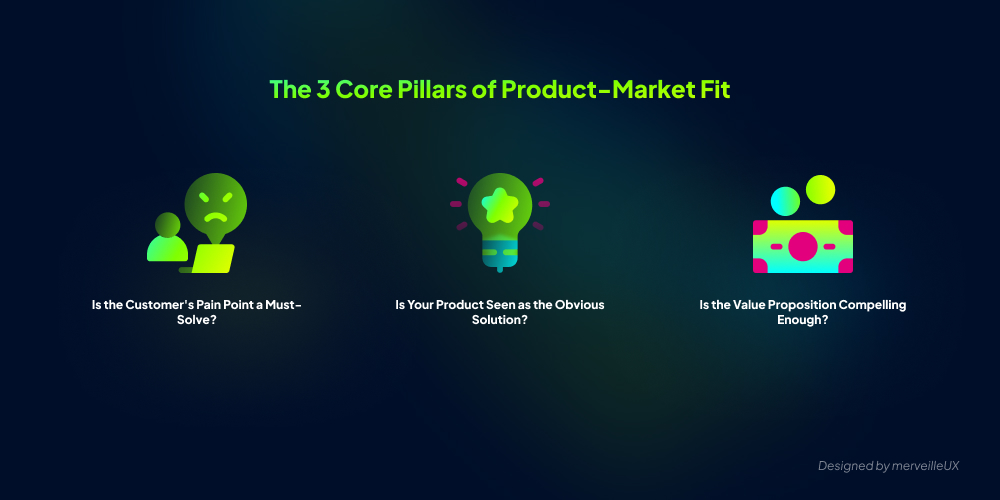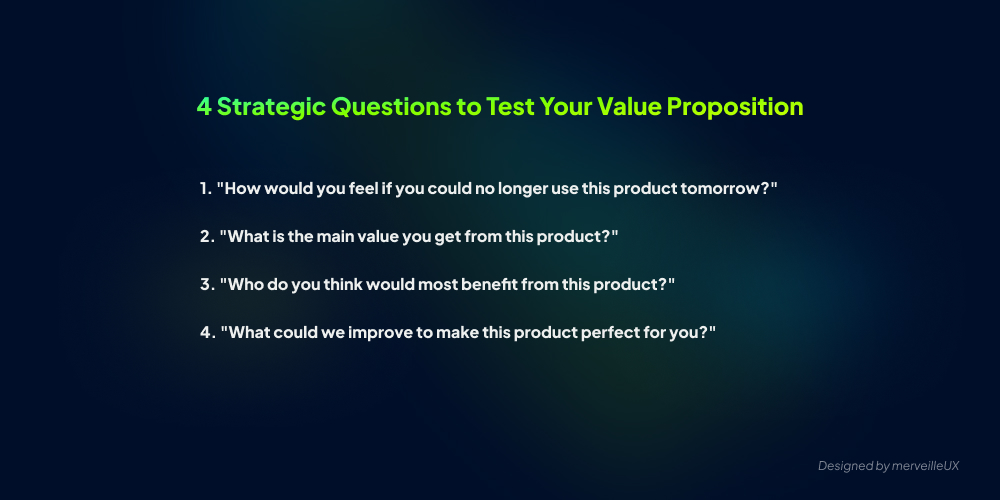You know that feature? The one your dev team bled for, now sitting in a dusty corner of your UI, ignored by your customers. That's not just a miss—it's the costly symptom of a shaky Product-Market Fit (PMF). So, before you burn another dollar on your roadmap or go all-in on scaling, let's get brutally honest. Does your product solve a real, painful problem your target market will actually pay to fix? Forget the theory. This article is a hands-on playbook. We're giving you a step-by-step testing protocol to validate your value prop, get a hard number on your Product-Market Fit, and finally build a business based on proof, not hope.
Table of contents
User Testing Beyond UX: Validating Your Value Proposition
Let's be clear: if your user tests are only focused on ergonomics, you're just scratching the surface. Polishing the interface of a product that nobody truly needs is the fastest way to burn through your resources.
The real challenge, the one that separates a successful SaaS from a cautionary tale, isn't whether a user can use your product. It's whether they desperately need it. It's time for a new perspective.
From Usability Testing to Value Testing: A Paradigm Shift
Classic usability testing is about efficiency. It focuses on HOW your customer interacts with your interface: Is the user flow smooth? Is the navigation clear? Its goal is to reduce friction. That's necessary, but not sufficient.
Value validation testing gets to the WHY. Its objective is to confirm that your product has a place in the market. It asks much more fundamental questions:
- Is the problem you're solving a priority for your target audience?
- Is your solution perceived as the best option, or just another one?
- Is your product's value proposition strong enough to justify a purchase?
Its goal is to ensure you're building an indispensable product, not just a "nice-to-have" tool. This is the very foundation of your Product-Market Fit.
How to Know If You've Achieved Product-Market Fit (PMF)
To avoid lying to yourself with false positives, your testing strategy must be built on three fundamental pillars. They are the foundation of your business model and determine whether your product has a real place in the market.
The 3 Pillars That Define Your Product-Market Fit
Pillar #1: The Criticality of the Customer's Problem
A customer won't pay for a product that solves a minor issue. Your mission is to find out if the need you're addressing is a simple nuisance or a critical problem that directly impacts the productivity or costs of your target audience. If your users talk about it with frustration and specific examples, you're onto a real market opportunity. If their reaction is lukewarm, your value proposition is likely too weak.
Pillar #2: The Relevance of Your Product as a Solution
Identifying a major problem isn't enough. Is your product perceived as THE obvious solution? A user test must reveal if your value proposition is understood instantly. If you have to explain the benefits for ten minutes, your solution isn't clear or relevant enough. A great product should sell its own value effortlessly.
Pillar #3: The Willingness to Pay for Your Offer
This is the ultimate moment of truth. A "this is awesome!" doesn't pay the bills. The real question is: is the perceived value of your offer strong enough for a customer to pay your price AND make the effort to switch from their current solution? This switching cost is a hidden barrier many underestimate. Without a firm "yes" to this question, your future growth and retention rate are at risk.

The "Truth Test" Protocol: A Concrete Method to Validate Your Concept
Enough theory. Here's our method to implement an effective testing protocol, designed to get honest answers and validate your product concept. Think of it as a crash test for your growth strategy.
Phase 1: Recruiting the Right Testers (and Avoiding False Positives)
This is the most critical step. If you test your product with your early fans or friends, you won't get objective feedback; you'll get polite encouragement. That's worthless for building a viable business.
Your mission is to find potential users who perfectly match your target audience (persona) but have no emotional attachment to your project. You need impartial opinions.
The game-changing tip: Don't look for "curious" people. Look for potential customers who are actively suffering from the problem you aim to solve. The best target?
- Users of a competing solution who complain about its limitations.
- Those who have cobbled together a "duct tape" system with spreadsheets to fill a gap in the market.
These people feel the "pain" daily. Their feedback is an invaluable resource for your product development.
Phase 2: Conducting the Interview to Uncover Real Needs
The interview has three steps. The golden rule: resist the urge to pitch your product in the first minute. The goal is to understand your customer, not to sell yourself.
Step 1: Validate the Pain Before Presenting the Product
Start by taking an interest in your user's daily routine. Your goal is to understand their workflow, their real needs, and their frustrations. This is the listening phase to confirm the existence and intensity of the problem.
Ask open-ended questions to encourage them to talk:
- "Tell me how you manage [problem X] today, from A to Z."
- "What's the most frustrating or time-consuming part of this process?"
- "If you had a magic wand, what's the one thing you would change?"
Listen for strong words: "frustrating," "complicated," "waste of time." If they don't come up, the need you're addressing may not be a priority for your target market.
Step 2: Present the Solution and Watch for Reactions
Only now can you present your solution (a clickable prototype, a demo...). Don't list every feature. Focus on your core value proposition and show it in action on a key use case.
Then, be quiet and observe. The user's reaction is a moment of truth. Do their eyes light up? Do they lean into the screen? Do they cut you off with, "Wait, does that mean I can finally..."? That's the "aha!" moment that signals your product has hit a nerve. A polite "Oh, that's nice" is a weak signal.
Step 3: Asking the 4 Strategic Questions to Quantify Value
To conclude the interview, ask these four questions. They are designed to go beyond opinion and probe the real value perceived by the user.
1. "How would you feel if you could no longer use this product tomorrow?"
- What you're measuring: The level of dependency. A "Very disappointed" response indicates your product has become indispensable. This is the key question for evaluating your PMF.
2. "What is the main value you get from this product?"
- What you're measuring: The clarity of your value proposition. If users describe the main benefit in their own words and it matches your marketing strategy, your message is clear.
3. "Who do you think would most benefit from this product?"
- What you're measuring: The relevance of your target market. If their answer describes your ideal persona, your targeting is spot on. If the answer is vague ("everyone"), your positioning needs to be refined.
4. "What could we improve to make this product perfect for you?"
- What you're measuring: Opportunities for development. The answers here are an invaluable source of information for your product roadmap, based on the real needs of your most engaged customers.

Phase 3: How to Measure Product-Market Fit and Analyze the Results
You've gathered feedback from your users. Now it's time for analysis, where you'll turn these conversations into a clear signal for your strategy. The goal is to measure your PMF and define concrete actions for your product roadmap.
The 40% Test: Your Quantitative PMF Indicator
To get a tangible indicator, we use the Sean Ellis framework. It's based on the answer to the key question: "How would you feel if you could no longer use this product?". Classify the answers into three categories:
- Very disappointed
- Somewhat disappointed
- Not disappointed
The rule is simple: you've reached a strong signal of Product-Market Fit when over 40% of your users answer "Very disappointed."
It's not a magic number; it's a threshold of truth. Below this rate, your product is likely a "vitamin" (nice-to-have). Above it, it's becoming a "painkiller" (must-have). Even with a small sample of 10 targeted testers, this ratio is an excellent early indicator.
Qualitative Analysis: Turning Feedback into Action for Your Roadmap
The 40% figure is your compass, but the treasure is in the qualitative analysis of "why." This is what will fuel your development roadmap.
- Analyze the "Very Disappointed": Who are they? Their profile defines your core target audience. Their words describe your most powerful value proposition. Focus your marketing and development on this segment.
- Interview the "Somewhat Disappointed": They represent your biggest growth opportunity. Ask them: "What would it take for our solution to become indispensable for you?". Their answers are the next features for your roadmap.
- (Almost) Ignore the "Not Disappointed": Don't try to build a product for everyone. These people are likely not your target market. Thank them for their time and focus your resources where they'll have the most impact.
Conclusion: Move from Guesswork to Evidence to Secure Your Growth
Let's be honest: a product roadmap based solely on intuition is like betting your investors' money and your team's time on a poker hand. It might pay off, but it's rarely a sustainable strategy. A great design or cutting-edge tech will never save a product that solves a problem nobody really has.
This testing protocol isn't a magic formula. It's a brutally effective risk-reducer. It allows you to shift from hope-based growth to evidence-based growth. It turns a costly roadmap into a smart investment plan.
The result of these tests isn't just a "yes" or "no." It's a precise diagnosis:
- Is your value proposition misunderstood? It might be time to rethink your mockups.
- Does your product lack credibility or consistency? A Design System could be the solution.
- Are your users interested but not "hooked"? Gamification can create the engagement you're missing.
So, before you pitch your vision to your investors or kick off the next development sprint, the question remains the same: what evidence is your strategy built on?
The success of your SaaS isn't determined by the speed of your development, but by the relevance of your direction. We help you find the right direction and build the UX solutions to get you there. Let's talk about your project.



